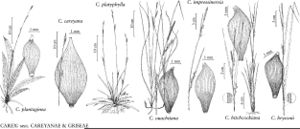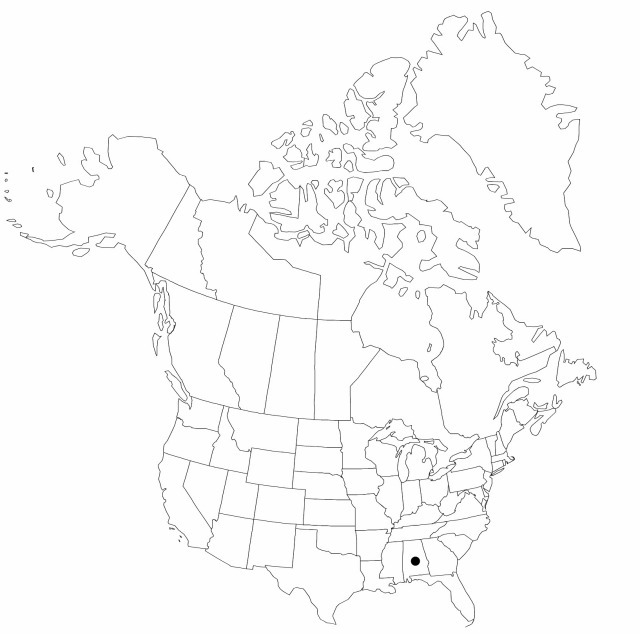Carex brysonii
Contr. Univ. Michigan Herb. 19: 195, figs. 1a, c, e, 2a, b. 1993.
Plants densely cespitose; rhizome internodes 2.4–2.7 mm thick. Culms yellow-brown to red-brown at base, 25–60 cm. Leaves: sheaths scabrous; blades, especially of overwintered leaves, glaucescent, widest blades (3.4–)3.7–5.8(–6.1) mm wide, smooth or papillose abaxially, papillae especially on overwintered leaves. Inflorescences 0.22–0.86 of culm height; peduncles of lateral spikes smooth or barely scaberulous; peduncles of terminal spikes 6.6–42(–58) mm, barely to much exceeding lateral spikes; proximal bract with sheath tight, abaxially scabrous, sheath front apex slightly convex, elongated 0.3–3.7(–4.4) mm; ligules 0.7–3.4 mm; distal bract overlapping but not exceeding terminal spike. Spikes (3–)4–5(–6), separate or distal 2–4 overlapping; lateral spikes pistillate or rarely androgynous, with (2–)3–11 perigynia, 6–39 × 3.8–6.8 mm, ratio of spike length (in mm) to flower number = 2.3–4.9; terminal spikes (12–)18–46 × 1.4–3 mm, longest ones (25–)30–45 mm. Pistillate scales (3.5–)4.1–7 × 1.3–2.5 mm, margins whitish, entire, apex with awn (0.1–)1.2–4.1 mm. Staminate scales 3.8–4.3 × 1.3–1.6 mm. Anthers 2.9–3.4 mm. Perigynia spirally imbricate, 49–58-veined, unwrinkled, narrowly ellipsoid to obovoid, obtusely triangular in cross section, (3.7–)4–4.7(–5.1) × 1.5–1.7(–1.8) mm, (2.2–)2.5–3.1 times as long as wide, dull, base gradually tapered, apex abruptly contracted; beak slightly excurved, (0.5–)0.6–1 mm. Achenes broadly obovoid-ellipsoid to obovoid-ellipsoid, (2.5–)2.7–3.5 × 1.4–1.6(–1.7) mm, tightly enveloped by perigynia; stipe 0.3–0.5(–0.6) mm, bent 5–45°; beak 0.2 mm, bent 30–70°.
Phenology: Fruiting spring.
Habitat: Mesic deciduous forests, in sandy loams and loamy sands on slopes above streams
Elevation: 90–200 m
Discussion
Of conservation concern.
Carex brysonii is very rare and local. It is known from only five populations, all in the drainage of the Black Warrior River.
Selected References
None.

